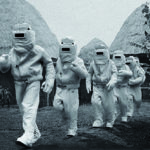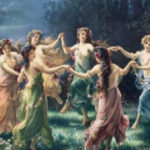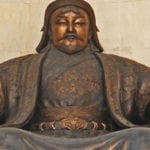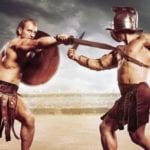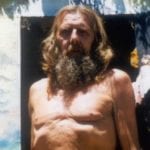 Weird Stuff
Weird Stuff  Weird Stuff
Weird Stuff  Mysteries
Mysteries 10 Tragic Disappearances and Deaths in Joshua Tree National Park
 History
History 10 Ways Childhood Really Sucked in the Old West
 Music
Music 10 Name Origins of Famous Bands from the 1990s
 Religion
Religion 10 Biggest Turnarounds by the Catholic Church
 Weird Stuff
Weird Stuff 10 Unbelievable Times Laws Had Unintended Consequences
 Humans
Humans Ten Historic Women Who Deserve Way More Credit Than They Got
 Movies and TV
Movies and TV 10 Films That Spawned Major Lawsuits
 History
History Ten Times Towns Were Wiped Off the Face of the Earth
 Creepy
Creepy 10 of the Most Disturbingly Haunted Public Houses in the UK
 Weird Stuff
Weird Stuff 10 Niche Subcultures That Are More Popular Than You Might Think
 Mysteries
Mysteries 10 Tragic Disappearances and Deaths in Joshua Tree National Park
 History
History 10 Ways Childhood Really Sucked in the Old West
Who's Behind Listverse?

Jamie Frater
Head Editor
Jamie founded Listverse due to an insatiable desire to share fascinating, obscure, and bizarre facts. He has been a guest speaker on numerous national radio and television stations and is a five time published author.
More About Us Music
Music 10 Name Origins of Famous Bands from the 1990s
 Religion
Religion 10 Biggest Turnarounds by the Catholic Church
 Weird Stuff
Weird Stuff 10 Unbelievable Times Laws Had Unintended Consequences
 Humans
Humans Ten Historic Women Who Deserve Way More Credit Than They Got
 Movies and TV
Movies and TV 10 Films That Spawned Major Lawsuits
 History
History Ten Times Towns Were Wiped Off the Face of the Earth
 Creepy
Creepy 10 of the Most Disturbingly Haunted Public Houses in the UK
10 Things You Probably Don’t Know About Star Trek
Star trek is one of the biggest cultural phenomenons in the history of mass media. There are a lot of people who know a lot about Star Trek, but they often know less than they think. In a series spanning ten movies, a half dozen television series, not to mention comic books, video games and novels, a lot of perfectly fascinating bits of trivia get overlooked, and many intriguing mysteries crop up.
There are a number of bands that dedicate themselves to a certain theme or fiction. Metallica wrote a number of songs using H.P. Lovecraft’s Cthulhu mythos, Blind Guardian is well known for writing within the fiction of the Lord of the Rings, and California Punk band “No Kill I” is well known for writing songs exclusively about Star Trek. Drawing their name from a line in the original Series episode “The Devil in the Dark”, the band has been playing local venues in and around Sacramento California for years, though the band describes their own performances as “On-stage drinking contests” That “Ultimately descend into chaos”. Surprisingly, No Kill I is not the only star trek themed band. There is also No Kill I: the Next Generation, Warp 11, William Shatner’s Pants, The Romulans and Klingon-speaking death metal band: Stovokor.
One Particular episode of the Star Trek animated series “The Slaver Weapon” had a lot of Star Trek fans scratching their heads. The episode, dealing with Spock, Sulu and Uhura trying to keep a powerful ancient weapon from a cat-like race called the “Kzinti” it was entertaining enough, but it just didn’t feel like Star Trek. The Story was surprisingly sophisticated for a kid’s show, and included many elements that typically were not explored in Star Trek (Billion year old lost Technology, strange non-humanoid aliens, an adventure on a moon without an atmosphere) and several things that seemed somewhat out of character for the Star Trek Gang, such as Spock (a Pacifist) drop-kicking the bad guy and breaking several of his ribs. The reason the show was so different is simple: When asked to write an episode for the Animated Star Trek, popular Sci-fi author Larry Niven decided to adapt his classic short story “The Soft Weapon” into an episode, instead of writing something from scratch. Explaining why Niven’s favorite villains, the Kzinti, were now a race in Star Trek. Despite it being a bit strange for a Star Trek episode, “The Slaver Weapon” is a fan favorite.

Star Trek II: The Wrath of Khan is considered by many fans one of the best star trek films ever made. Since it is the most popular Star Trek film it is perhaps the most abound with rumors. After it’s release the main way to watch the movie was on grainy VHS, where villainous lead Khan’s muscular chest looked a bit too shiny to be real. This spawned the rumor that actor Ricardo Montalban used a plastic chest appliance under his shirt. For years, this myth was a popular myth among fans, even being referenced in the Animaniacs “Star Truck” parody. However, when the movie was remastered many began to doubt the rumor, the clearer picture showed a more natural looking chest. Now it’s known that there was no “Plastic chest” just 100% Khan. Montalban is a “Very large and muscular man” according to a statement by “Wrath of Khan” director, Nicholas Meyer. When asked on the Johnny Carson show how he got such a physique at age 63, Montalban replied “Push-ups, lots of Push-ups”

Japan is a country that loves science fiction and fantasy programing, their television staple includes few shows without some fantasy element. Star trek: the Next Generation aired there soon after it’s release in America, and was quite popular. However, the original series (Re-broadcast in Japan around the 1970s) had fairly poor ratings, and it lasted only a few weeks on the air. With the Popularity of “The Next Generation” in Japan mounting, Paramount encouraged Nippon TV to try the original series again, but it was still wildly unpopular. The reason? An article in Geek Magazine revealed that many young Japanese Trekkies, unfamiliar with the original series, dismissed it as a poorly done copy of The Next Generation! An old rumor in the Trek fandom states that, in Japan, the original series was called “The Adventures of Captain Sulu” This is, of course, false.

As most Trek fans are aware, the original series didn’t get past season three, but there were plans for a fourth season. A couple of these ideas were revealed in an interview with Gene Roddenberry in “The making of Star Trek” A book originally published during the show’s first run. Roddenberry admitted he planned on including Leonard McCoy’s Daughter as a new crew member, and that there would be tension between him and Kirk who would be very attracted to McCoy’s daughter. He also stated that Spock would begin wearing a “Medallion of Vulcan origin” that would put him at odds with sticklers of regulation, since the Medallion would not be proper uniform. This latter idea was recycled for Lt. Worf on The Next Generation, who had special permission from Starfleet to wear a Klingon sash with his uniform. McCoy’s daughter was only mentioned once, on an episode of the animated series.
There’s no doubt that Star Trek fans are some of the most dedicated in the world, and sometimes this fan dedication reaches amazing levels. None is more evident than a group of fans who got together in southern California to produce new Episodes of the original series. The Cast and crew of “Star Trek: Phase two” pay for props, film and costumes our of their own pockets, knowing that they can’t make a dime on their hard work due to copyright issues. The quality of the production has attracted actual star Trek alumni like Walter Konig, George Tekai, Grace Lee Whitney and Denise Crosby not just to cameo in the series, but play large roles. One episode is even written by famous Star trek Writer D.C. Fontana! Work on the sets were so accurate, the television show “Star Trek: Enterprise” used a few set pieces for their own show. Oddly enough the director of the show, James Cawley, who also plays Kirk, is an Elvis impersonator by trade.
In 1994, comic book writer Greg Weisman got his big break, creating the show “Gargoyles” for the Disney afternoon lineup. The show went on to the highest rated animated show Disney ever produced. Due to circumstances only known to the entertainment world, the show features a bizarre number of actors and actresses that were veterans of Star Trek. Jonathan Frakes, Marina Cirtis, Colm Meaney, Michael Dorn, Kate Mulgrew, Bret Spiner, Nichelle Nichols, David Warner and Avery Brooks all appeared. There are many rumors as to why this is true, some say Greg Weisman is a Trek fan, other say Jonathan Frakes (who was cast first as the shows main protagonist, David Xanatos) loved voice acting so much he encouraged other Trek alumni to give it a try. Some say it was an experiment/running gag by the producers to see how many Trek actors could be crammed into the show before anyone noticing the trend, but none of these have been substantiated. Greg Weisman always feigns ignorance when asked why so many Star Trek alumni are on the show, and Jonathan Frakes simply commented “It just kinda turned out that way,” There are a number of other trek-related jokes on the show, including one episode where a suspected alien is taunted by a character saying “Oh yeah? You and what Starfleet?”
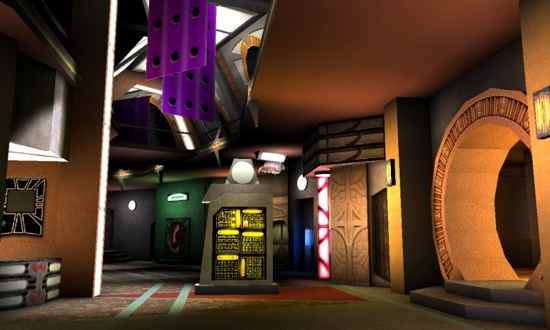
The set for Deep Space Nine’s promenade (the Space station’s commercial district) is one of the largest television sets ever built, and has perhaps one of the largest collection of geeky in-jokes of any set in history. The promenade’s directory has a large list of the stations businesses and operations centers In English, Klingonese, Vulcan, Ferengi, Cardassian and Bajoran. In English, some businesses reference other science fiction series, such as The Forbin Project (Colossus: The Forbin Project) Jupiter Mining Corp (Red Dwarf) Spacely Sprockets (The Jetsons) Millyways (Hitchhikers guide to the galaxy) and the much more obscure Banzai Institute (From cult sci-fi classic “The Adventures of Buckaroo Banzai”) and Tom Servo’s used robots (From late night cable show Mystery Science Theater 3000) There’s also references to real life establishments, “Pancho’s Happy bottom riding club”, a California bar Air Force test pilots frequented, and “Vince’s Gym” a gym on Ventura boulevard in Studio City, California, known for it’s famous clientele. Set Dresser Michael Ochuda is notorious for his screen readouts including geeky background jokes.
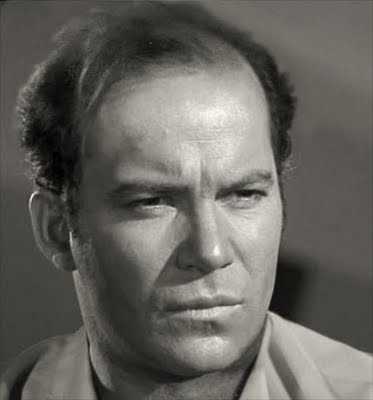
A good 40 years since the original broadcast of Star Trek, and there still is no clear answer to the big question: Is Shatner’s quaff of hair real or store bought? Accounts notoriously conflict, some co-stars say he had hair and went bald after the series was filmed, other say Shatner wore a hair weave due to having naturally thin hair that looks bad under stage lights. Star Trek Co-star George Tekei claimed in a radio interview that Shatner was balding since the beginning, but Make-up artist Fred Phillips describes using a bald cap on Shatner in an episode where Captain Kirk had to age rapidly. There have been many hoaxes dealing with this mystery, including boatloads of photoshopped images popping up on the internet, and an e-bay auction that claimed to be selling Shatner’s old toupee. There’s even a blog dedicated to solving this mystery here. Is he really bald, and if so, how bald and how long has he been bald? William Shatner, himself, is possibly the only man alive who knows the answer to all these questions, and he’s not talking.
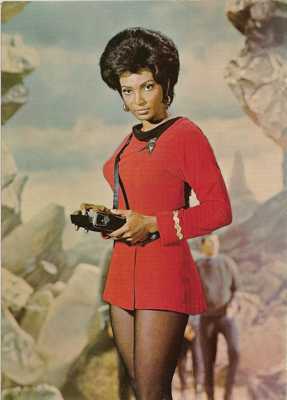
These days television and movies go to great lengths to show how diverse and racially sensitive they are, with casts becoming cultural rainbows of every race, religion, sexual orientation and political persuasion. However, in the 1960’s the world was just getting over crude racial stereotypes like Charlie Chan and the Frito Bandito. When African American actress Nichelle Nichols was cast in Star Trek, Gene Roddenberry said he did it because he wanted the Enterprise to include people from every nationality, not realizing how radical it was to depict a black woman as an equal on 60’s television. Nichols said she enjoyed the job, but thought television was a little tedious and was thinking of leaving the show. Nichols recollects that during a promotional trip to Memphis, an assistant told her that a fan wanted to meet her. Expecting to meet another doting young man, she was surprised to meet Martin Luther King Jr. She confided in the Revered that she was thinking of leaving the show, and was taken aback when he abruptly told her she could not. He told her “Don’t you understand? When you are there they see you as you should be seen, as an equal,”. Needless to say, she didn’t leave the show, and Star Trek took a bold step forward for diversity.
